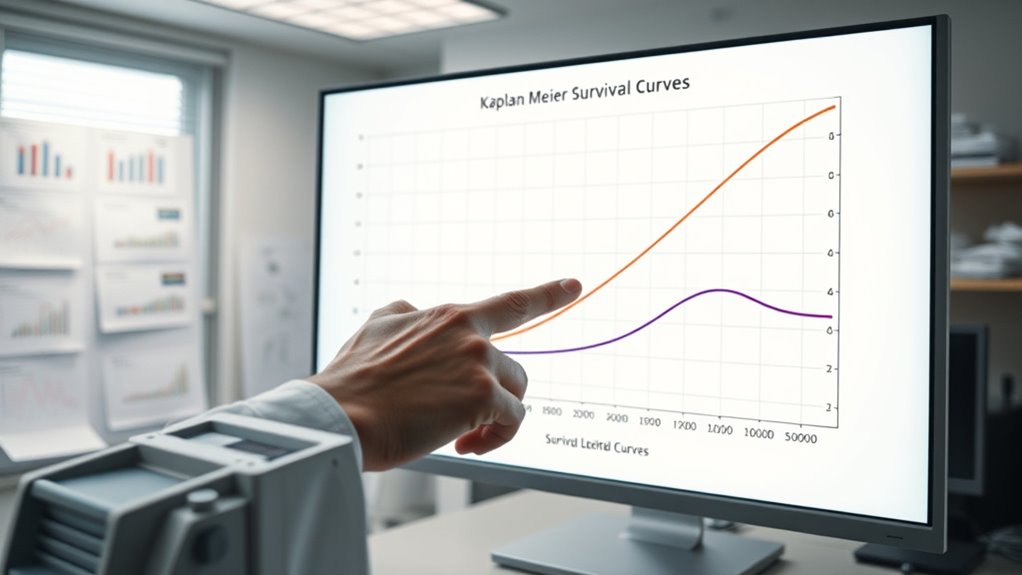Survival analysis uses statistical techniques to examine how long it takes for an event to occur, like recovery or failure. It involves estimating functions like survival and hazard, which reveal risk patterns over time. Handling incomplete data through censoring methods, especially right-censoring, guarantees your results remain accurate. These tools help you understand risk dynamics and factors influencing timing. Keep exploring to uncover how these methods can provide deeper insights into time-to-event data.
Key Takeaways
- Survival analysis models the time until an event occurs, accounting for censored data to avoid bias.
- The hazard function measures the instantaneous risk of the event at any given time point.
- Censoring methods, such as right-censoring, enable inclusion of incomplete or ongoing observations.
- Techniques like the Kaplan-Meier estimator and Cox proportional hazards model estimate survival and risk patterns.
- Proper application of these methods helps identify factors influencing survival and risk dynamics over time.

Have you ever wondered how researchers determine the time it takes for an event to occur, such as patient recovery or equipment failure? Survival analysis provides the tools to answer these questions by analyzing time-to-event data. One key concept in survival analysis is the hazard function, which measures the instantaneous risk of the event happening at a given moment, assuming it hasn’t occurred yet. Think of it as the probability that, just at this precise time, the event will occur, given survival up to that point. Understanding the hazard function helps you grasp how the risk changes over time—whether it increases, decreases, or remains constant. For example, in medical studies, the hazard might be higher immediately after treatment and then decline, or it could remain steady.
Handling real-world data isn’t always straightforward because not all observations are complete. Some subjects leave the study early, are lost to follow-up, or the study ends before the event occurs. This is where censoring methods come into play. Censoring allows you to include incomplete data without biasing your results. For instance, right-censoring occurs when a patient hasn’t experienced the event by the end of the study period, but you still know how long they were observed. Left-censoring and interval-censoring are other types, depending on when the event is known to have occurred or the timeframe within which it happened. Properly applying censoring methods ensures your analysis accurately reflects the uncertainty inherent in incomplete data, giving you a more reliable picture of the true survival experience. Additionally, understanding the impact of censoring on your data is crucial for selecting appropriate statistical models and ensuring valid results.
In survival analysis, you typically start with estimating the survival function, which shows the probability of surviving beyond a certain time. The hazard function complements this by illustrating the risk pattern over time. When you combine hazard functions with censoring methods, you can build more sophisticated models, like the Cox proportional hazards model, which helps identify factors influencing survival. This approach allows you to account for varying risks and censored observations simultaneously, making your estimates more precise. By understanding how hazard functions behave and applying appropriate censoring techniques, you can extract meaningful insights from complex time-to-event data, whether you’re studying patient outcomes, machine reliability, or other phenomena where timing matters.
Frequently Asked Questions
How Do I Handle Competing Risks in Survival Analysis?
To handle competing risks in survival analysis, you should focus on the cumulative incidence function, which estimates the probability of a specific event happening before a certain time while accounting for other risks. Instead of just using traditional survival curves, analyze each competing risk separately to accurately reflect their influence. This approach helps you understand the true risk of each event, providing clearer insights into your data.
What Are the Limitations of the Kaplan-Meier Estimator?
Imagine you’re watching a race where some runners drop out early. The Kaplan-Meier estimator, while useful, has limitations like bias from censored data and assumptions that censored individuals have the same risk as those remaining. These censoring challenges can skew your survival curves, making it hard to get an exact picture. Be aware of these biases, as they may lead you to overestimate or underestimate survival probabilities.
How Can I Incorporate Covariates Into Survival Models?
You can incorporate covariates into survival models by using techniques like Cox proportional hazards regression, which allows you to perform covariate selection and model adjustment. Start by identifying relevant covariates, then include them in the model to control for confounding factors. This approach helps improve the accuracy of your survival estimates and reveals how different variables influence the time-to-event outcome effectively.
When Should I Use Parametric Versus Non-Parametric Methods?
You should use parametric methods when you can confidently assume a specific data distribution, like exponential or Weibull, because they rely on model assumptions for accuracy. Non-parametric methods are better when data distribution is unknown or complex, as they don’t assume a specific form. Investigate whether your data fits these assumptions; if not, non-parametric approaches give more reliable results.
How Do I Interpret Hazard Ratios in Real-World Terms?
A hazard ratio compares the risk of an event happening at any moment between two groups. If the hazard ratio is 2, it means one group has twice the risk of experiencing the event compared to the other. Conversely, a hazard ratio of 0.5 indicates half the risk. Interpreting it in real-world terms helps you understand how different factors or treatments affect the likelihood of an event over time.
Conclusion
By mastering survival analysis, you understand not just the timing of events, but the story they tell about risk, duration, and chance. You learn to interpret data, predict outcomes, and make informed decisions. You grasp the importance of censored data, the power of hazard functions, and the value of survival curves. You embrace the complexity, apply the techniques, and unearth insights that can transform research, healthcare, and beyond. You become confident in steering time-to-event data with clarity and purpose.










